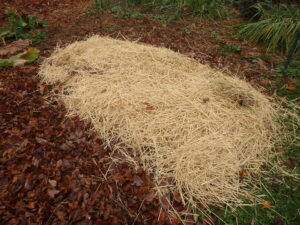Garlic Needs to Be Planted Now!
Posted on Tuesday, October 20, 2020 · Leave a Comment
When I was growing up, my mom served meat and potatoes nearly every night. Our vegetable was peas or cooked carrots, and once a week or so we had an iceberg lettuce salad with cucumbers, tomatoes and carrots with dressing from a bottle. So I don’t really know how I developed a taste for complex flavors. But I grow – and cook with – a lot of garlic, and find it adds depth and intensity to soups and stews. Now is the time to plant some for next year.
Growing garlic involves less work than anything else I grow. There really are only 3 steps: plant it, mulch it, and harvest it. Once you have an established bed of garlic, it’s also the least expensive crop. I planted this year’s crop from last year’s crop, and that one I planted from the crop of the year before. You really only have to buy garlic once – so long as you plant some extra and save it each year for planting. I choose my best looking, biggest garlic each year for planting.
The hardest part of planting garlic for the first time might be to find garlic sold for planting. You can’t just go to the grocery store to get garlic because much of it has been treated with chemicals to prevent it from sprouting, and most is the wrong kind for New England.
I went on-line to see about buying “seed” garlic. Many major suppliers are already sold out, and prices have sky rocketed since last year. Try your local farmer or farmer’s market – they may still have some.
There are basically just two kinds of garlic: soft neck garlic, which is what you probably get at your grocery store, and the stuff we grow here in the Northeast called hard neck garlic. Most soft neck garlic (the kind that is braided and hung on walls) comes from California and keeps nearly forever. It is less hardy than hard neck garlic, a bit bland, and less interesting to cook with.
Hardneck garlic has a stiff stem in the middle of each bulb. In my opinion it has a much more complex flavor. It will keep in a cool place until spring, but not much longer. Then it either sprouts or dries up. There are many named varieties of hardneck garlic- but all are excellent.
To plant garlic, take a bulb (or head) of garlic and separate it into the cloves that surround the hard “neck” or flower scape. Depending on the variety of garlic, you might have just five cloves, or as many as a dozen. I like big cloves, as they are easier to peel and use. So each year I select for big cloves and plant them. Over the years my crop has produced bigger bulbs and bigger cloves.
Garlic needs full sun (defined as 6 hours of sunshine) and rich soil. In a 30-inch wide raised bed I add a couple of inches of compost, and stir it into the soil, loosening the soil in the top 6 inches. To plant, I draw furrows 8- to 12-inches apart with my CobraHead weeder, a single-tine tool that is curved like a bent finger. Next I push cloves into the soil so that they are 3 or 4 inches apart and about 3 inches deep. Always plant them with the pointy end up. After covering them with soil I pat the soil down with my hands.

This thick layer of hay helps to prevent weeds in the garlic
The last step is to mulch your garlic. I use mulch hay or straw and put almost a foot of fluffy material over the bed. Fall rains and winter snows will cause the hay to settle – I end up with about 4 to 6 inches of material in the spring.
The mulch keeps the soil from freezing until January, allowing roots to get well established before the garlic cloves go dormant. It also prevents most weeds from germinating and growing next year, though I weed the bed well before planting, which helps, too. Garlic is tough stuff and will push right through my layer of mulch, though most weeds do not.
Depending on the weather and when you plant, your garlic may send up green stalks this fall. Don’t fret if it does. Those sprouts will die back in winter, but the garlic will send up new ones in the spring.
Next July the garlic you planted this year will be ready to harvest. Each bulb grows about 7 long pointy leaves that surround the cloves and protect them. When 3 or 4 leaves have turned brown and started to dry up, it’s time to harvest. If you wait too long, all the leaves will have dried up and the garlic will not store as well – it will dry out too soon.
You can store garlic best in a cool, dry place. Ideally 50 degrees with moderate humidity. You can also freeze garlic instead of storing it at room temperature, I’ve read (but I’ve never tried that). For freezing, separate the cloves, but don’t peel them. You can freeze them in a zipper bag or jar for a year or more. Don’t store garlic at room temperature in oil, as it can produce deadly botulism.
For centuries some cultures have believed that garlic helps ward off colds and the flu. Maybe it will even help to defeat Covid-19. Or maybe good garlic breath will just get that guy behind you in the check-out line with no mask to stand back a little!



